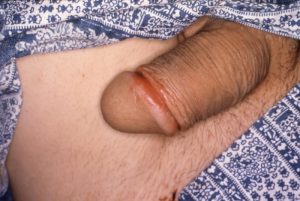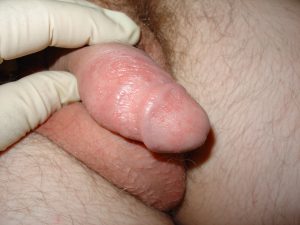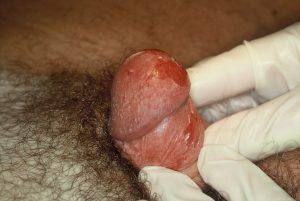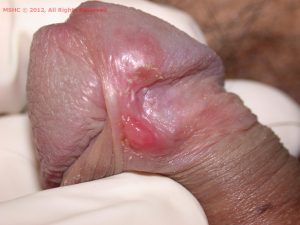This post is also available in:
![]() 简体中文 (Chinese (Simplified))
简体中文 (Chinese (Simplified)) ![]() ไทย (Thai)
ไทย (Thai) ![]() 한국어 (Korean)
한국어 (Korean)
Balanitis, posthitis & balanoposthitis are conditions that cause inflammation of the head of the penis and foreskin. These conditions can be a sign of an STI OR a non-sexually transmitted skin infection, so diagnosis and treatment can vary. Balanitis and posthitis occur more often in people with uncircumcised penises and will affect up to 10% of people with penises at least once in their lifetime. Most cases are easily treated with good hygiene, creams, and ointments.
Balanitis is inflammation of the skin on the head (glans) of the penis. It’s caused by the growth of bacteria and/or fungus inside the foreskin.
Posthitis is inflammation of the foreskin.
Balanoposthitis is inflammation of both the skin on the head of the penis and the foreskin.
These conditions are not necessarily contagious, but it’s important to know what’s causing the infection. Balanitis, posthitis & balanoposthitis can often be symptoms of other STIs such as herpes, trichomoniasis, chlamydia, and gonorrhoea.
Signs and Symptoms
Content warning: click to show images






Penis
Signs and symptoms of balanitis, posthitis & balanoposthitis may include:
- Redness
- Itching
- Swelling
- Tenderness of the head of the penis and its surrounding foreskin
Common Causes
- Poor hygiene, not cleaning under the foreskin of the penis properly
- STIs such as herpes, trichomoniasis, chlamydia, and gonorrhoea
- Infection with candida (thrush) or bacteria that live on the skin
- Chemical irritations – harsh soaps, disinfectants and lotions
- Other skin conditions such as psoriasis or dermatitis
- Allergies to certain medicines or latex condoms
- Phimosis, an inability to retract the foreskin, can occur alongside either balanitis or balanoposthitis and be a symptom, cause, or both.
Prevention
- Wash the end of the penis (the glans) each day.
- Pull the foreskin back gently whilst in the bath or shower
- Gently clean the glans using just water, or water and a gentle soap
- Make sure the penis, including the glans, is dry before you put on underwear
- STI prevention measures can help to prevent balanitis, posthitis & balanoposthitis.
- If symptoms are related to condom use, try using a condom designed for sensitive skin.
- Wash your hands before going to the toilet if you work with skin-irritant chemicals.
Diagnosis
- Balanitis, posthitis & balanoposthitis are descriptive terms for symptoms caused by irritation.
- Your doctor might begin by asking you about your symptoms and examining your penis.
- They may take a swab sample from the head or foreskin.
- Depending on your symptoms, tests such as a blood test or a biopsy might also be necessary.
- You might need to see a doctor who specializes in skin conditions (dermatologist).
- Your doctor will want to rule out other serious conditions, particularly if your symptoms keep coming back or aren’t improving.
Treatment
Treatment depends on the cause. You should see a doctor if symptoms persist or worsen.
There are a variety of ways to manage balanitis, posthitis & balanoposthitis, including the hygiene practices mentioned above. You can also get prescription antibiotics and/or antifungal creams or ointments to treat an infection.
How might this impact my work?
- You can have sex during treatment if your inflammation is not caused by infection, like an STI or thrush, but it may be uncomfortable.
- If it is caused by an infection, there’s a risk of passing this on during sex. You will need to treat that infection to protect yourself and others.
- Balanitis, posthitis & balanoposthitis might make sex painful.
- Balanitis, posthitis & balanoposthitis can also cause erectile dysfunction.
